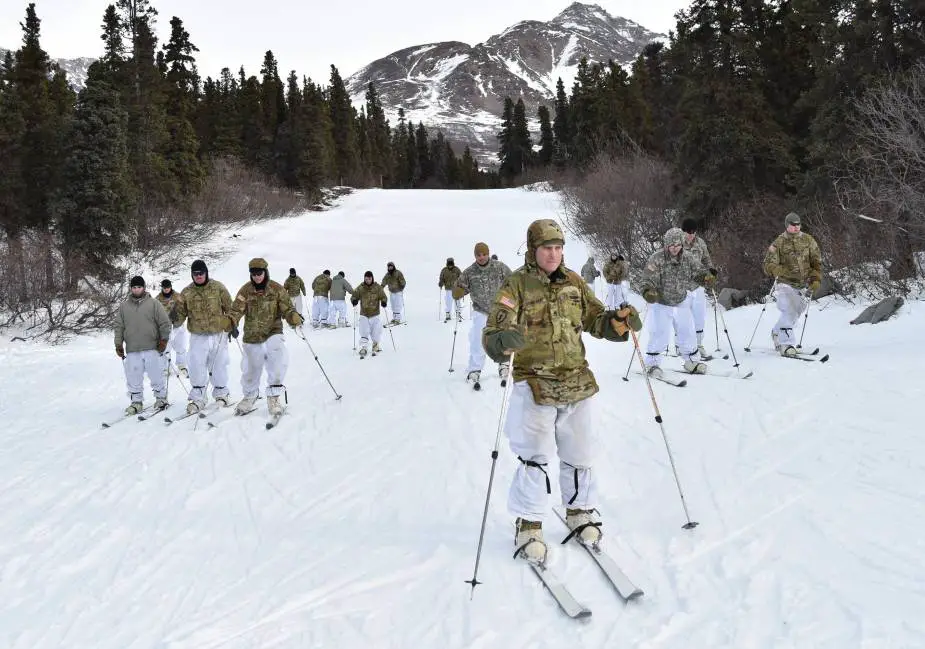US Army chief of staff discusses Arctic strategy and Indo-Pacific presence
The U.S. Army recently completed a new Arctic strategy that aims to protect assets in the region as it continues to recalibrate its forces around the world to deter near-peer adversaries. Sean Kimmons, Army News Service, reports.
Follow Army Recognition on Google News at this link

U.S. soldiers practice cross-country ski techniques during a cold weather leaders course at the Northern Warfare Training Center, Alaska, March 6, 2019 (Picture source : U.S. Army/John Pennell)
Chief of Staff Gen. James C. McConville said on 19 January that the strategy mainly focuses on Alaska and could upgrade its two-star headquarters into an operational headquarters. Other plans include establishing a Multi-Domain Task Force as well as an Arctic-capable brigade in the region : “Optimizing the employment of our forces and being able to demonstrate our capabilities through combined exercises and power projection are critical,” he said during an Association of the U.S. Army Noon Report.
In October 2020, senior leaders announced the Army was developing a new framework to help integrate and synchronize the service to meet regional requirements, all while providing predictability during training and modernization efforts. Called the Regionally Aligned Readiness and Modernization Model, or ReARMM, the framework also looks to enable the Army to transform into a multi-domain capable force by 2035, which can be ready for competition, crisis and conflict. The model is slated to be in place by next fiscal year : “This is our method to maintain focus on current and future readiness while reducing the [operational tempo] challenges that strain our organizations and people,” McConville said.

Army Chief of Staff Gen. James C. McConville speaks during an Association of the U.S. Army Noon Report in Arlington, Va., Jan. 19, 2021. (Picture source : U.S. Army/Screenshot image)
A forward presence and strong partnerships in the Indo-Pacific region will also be crucial in the era of great competition, he said. In the past 18 months as the chief, McConville said he has visited several countries during four separate trips to the Indo-Pacific to meet with partners. He plans to conduct two more trips to the region in the near future : “We are focused on maintaining and enhancing those relationships,” he said. This year, the Army is slated to conduct another Defender Pacific exercise that will center on southwest Pacific. In it, Army units will plan to draw prepositioned stock in the region, exercise Army watercraft, as well as employ a Multi-Domain Task Force, he said.
The task forces have become the organizational centerpiece for the Army’s ongoing transformation, he added. The agile units, tailored to a theater’s operational requirements, have the capability to provide long-range precision effects and fires to penetrate an enemy’s anti-access/area denial capabilities : “We are enhancing our ability to set the theater to ensure we have access, basing and infrastructure in place to rapidly deploy forces when required,” he said.
Besides the task forces, he said aligning units through forward positioning, rotations and dynamic force employment can help the Army get the right calibrated force posture. As part of that, security force assistance brigades have played a role in improving foreign partnerships. Last year, nearly 60 Soldiers from the 5th SFAB trained alongside the Royal Thai Army to mark the first SFAB tour in the Indo-Pacific. SFAB units have now also been to Indonesia as well as Afghanistan, Colombia, and Senegal.
McConville also noted the importance of allowing foreign troops to attend the U.S. Army’s schools, adding that “iron-clad relationships” with strong partners help deter adversaries : “They get to see our values. They get to see what we’re all about,” he said. “They understand our doctrine and then we go out and meet with them. There’s a shared vision of the peace that we want.”
America’s goal remains winning without fighting. To deter aggression, the joint force must have an irrefutable demonstrated ability to fight and win, he said : “This inflection point that we have today requires us to apply innovation, creativity and information processes toward the application of combat power,” he added. “Our nation’s adversaries have closed the joint force’s qualitative and quantitative advantages. “If the Army does not transform, it risks losing the ability to deter and preserve the nation’s most sacred interests.”


























